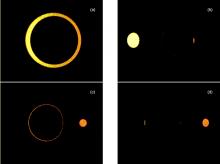
Abstract
We calculate the electromagnetic signal of a gamma-ray flare coming from the surface of a neutron star shortly before merger with a black hole companion. Using a new version of the Monte Carlo radiation transport code Pandurata that incorporates dynamic spacetimes, we integrate photon geodesics from the neutron star surface until they reach a distant observer or are captured by the black hole. The gamma-ray light curve is modulated by a number of relativistic effects, including Doppler beaming and gravitational lensing. Because the photons originate from the inspiraling neutron star, the light curve closely resembles the corresponding gravitational waveform: a chirp signal characterized by a steadily increasing frequency and amplitude. We propose to search for these electromagnetic chirps using matched filtering algorithms similar to those used in LIGO data analysis.